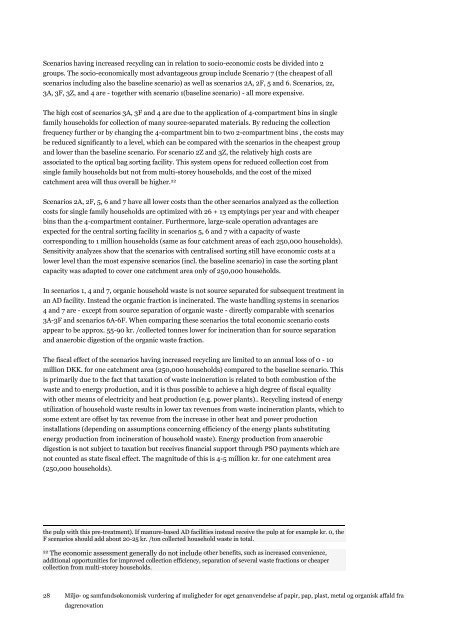Miljø- og samfundsøkonomisk vurdering af ... - Miljøstyrelsen
Miljø- og samfundsøkonomisk vurdering af ... - Miljøstyrelsen
Miljø- og samfundsøkonomisk vurdering af ... - Miljøstyrelsen
You also want an ePaper? Increase the reach of your titles
YUMPU automatically turns print PDFs into web optimized ePapers that Google loves.
Scenarios having increased recycling can in relation to socio-economic costs be divided into 2<br />
groups. The socio-economically most advantageous group include Scenario 7 (the cheapest of all<br />
scenarios including also the baseline scenario) as well as scenarios 2A, 2F, 5 and 6. Scenarios, 2z,<br />
3A, 3F, 3Z, and 4 are - t<strong>og</strong>ether with scenario 1(baseline scenario) - all more expensive.<br />
The high cost of scenarios 3A, 3F and 4 are due to the application of 4-compartment bins in single<br />
family households for collection of many source-separated materials. By reducing the collection<br />
frequency further or by changing the 4-compartment bin to two 2-compartment bins , the costs may<br />
be reduced significantly to a level, which can be compared with the scenarios in the cheapest group<br />
and lower than the baseline scenario. For scenario 2Z and 3Z, the relatively high costs are<br />
associated to the optical bag sorting facility. This system opens for reduced collection cost from<br />
single family households but not from multi-storey households, and the cost of the mixed<br />
catchment area will thus overall be higher. 22<br />
Scenarios 2A, 2F, 5, 6 and 7 have all lower costs than the other scenarios analyzed as the collection<br />
costs for single family households are optimized with 26 + 13 emptyings per year and with cheaper<br />
bins than the 4-compartment container. Furthermore, large-scale operation advantages are<br />
expected for the central sorting facility in scenarios 5, 6 and 7 with a capacity of waste<br />
corresponding to 1 million households (same as four catchment areas of each 250,000 households).<br />
Sensitivity analyzes show that the scenarios with centralised sorting still have economic costs at a<br />
lower level than the most expensive scenarios (incl. the baseline scenario) in case the sorting plant<br />
capacity was adapted to cover one catchment area only of 250,000 households.<br />
In scenarios 1, 4 and 7, organic household waste is not source separated for subsequent treatment in<br />
an AD facility. Instead the organic fraction is incinerated. The waste handling systems in scenarios<br />
4 and 7 are - except from source separation of organic waste - directly comparable with scenarios<br />
3A-3F and scenarios 6A-6F. When comparing these scenarios the total economic scenario costs<br />
appear to be approx. 55-90 kr. /collected tonnes lower for incineration than for source separation<br />
and anaerobic digestion of the organic waste fraction.<br />
The fiscal effect of the scenarios having increased recycling are limited to an annual loss of 0 - 10<br />
million DKK. for one catchment area (250,000 households) compared to the baseline scenario. This<br />
is primarily due to the fact that taxation of waste incineration is related to both combustion of the<br />
waste and to energy production, and it is thus possible to achieve a high degree of fiscal equality<br />
with other means of electricity and heat production (e.g. power plants).. Recycling instead of energy<br />
utilization of household waste results in lower tax revenues from waste incineration plants, which to<br />
some extent are offset by tax revenue from the increase in other heat and power production<br />
installations (depending on assumptions concerning efficiency of the energy plants substituting<br />
energy production from incineration of household waste). Energy production from anaerobic<br />
digestion is not subject to taxation but receives financial support through PSO payments which are<br />
not counted as state fiscal effect. The magnitude of this is 4-5 million kr. for one catchment area<br />
(250,000 households).<br />
the pulp with this pre-treatment). If manure-based AD facilities instead receive the pulp at for example kr. 0, the<br />
F scenarios should add about 20-25 kr. /ton collected household waste in total.<br />
22<br />
The economic assessment generally do not include other benefits, such as increased convenience,<br />
additional opportunities for improved collection efficiency, separation of several waste fractions or cheaper<br />
collection from multi-storey households.<br />
28 Miljø- <strong>og</strong> samfundsøkonomisk <strong>vurdering</strong> <strong>af</strong> muligheder for øget genanvendelse <strong>af</strong> papir, pap, plast, metal <strong>og</strong> organisk <strong>af</strong>fald fra<br />
dagrenovation

















